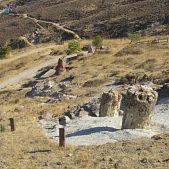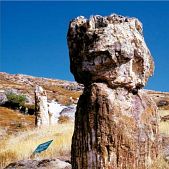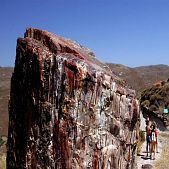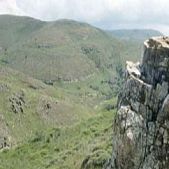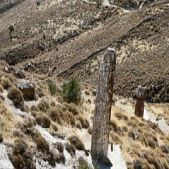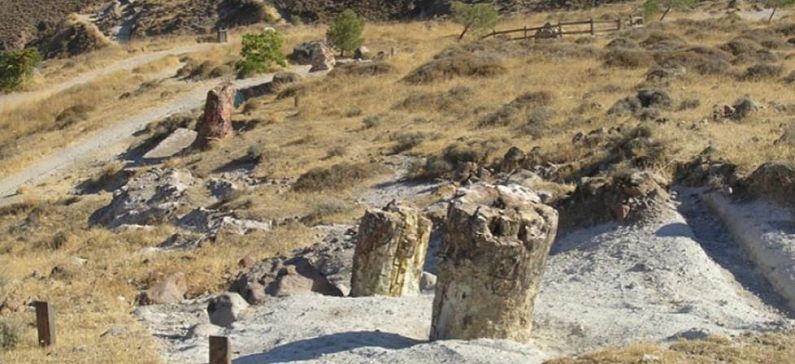
Petrified Forest of Lesvos on UNESCO’s World Heritage Monuments
The indicative list of UNESCO World Heritage monuments now includes the Petrified Forest of Lesvos. The process started a year ago and was completed in16-4-2014.
Located on the island of Lesvos, one of the most important natural heritage monuments in the world, the Petrified Forest of Lesvos, is a unique testament to the ecosystem that once existed in the Aegean region during the Miocene Epoch. The forest consists of hundreds of fossilized trunks, standing or downed, coniferous or fruit-bearing, which are scattered over an area of 15,000 hectares in major concentrations within the protected region and at many other sites in the layers of volcanic rocks.
To protect and promote the wonders of this ancient forest, the Greek state declared the area a Protected Natural Monument in 1985 (Presidential Decree 443 /1985). It has also been included in regions protected by the Barcelona Convention (Protection of the Mediterranean Sea against Pollution, OG235/A/1978).
The area of the Petrified Forest is also part of the European “Natura 2000” network (GR. 41100003).
The Lesvos Petrified Forest constitutes a fossilized forest ecosystem. It flourished in the Aegis region during the Burdigalian Period, in the Lower Miocene, approximately 18.5 million years ago. This forest was a mixed sub-tropical forest with a wide variety of vegetation, mainly conifers and fruit-bearing trees, which formed consecutive vegetation zones according to the morphology of the landscape.
During the Miocene, the whole area of the Aegean was a continental land with intense calc-alkaline volcanic activity that formed a series of volcanoes due to the subduction of the African tectonic plate under the Eurasian tectonic plate.
When the products of the volcanic eruptions blanketed the plants of the forest, all the plant organs were covered and fossilized in turn. Thus today, throughout the region, one can find fossilized branches and twigs, fruits, root systems and pieces of tree roots, as well as impressive fossils and imprints of leaves and animals living within or around the forest. The anatomical characteristics of the plants, such as the growth rings visible in cross-sections, the external part of the trunk, and the internal wood structure, are well preserved in all the fossils. The fossilized flora of the Petrified Forest includes large numbers of conifer and angiosperm (fruit-bearing) plants, with a smaller showing of pteridophytes. The fossilized trees include the highest standing fossilized tree in the world, with a height of 7.20 meters and a circumference of 8.58 meters. Trees in the petrified forest of Lesvos reach circumferences of 15 meters.
Nowadays the volcanic landscape of Lesvos Island presents a unique tomography of the crust, showing the complete sequence of the volcanic structures such as laccoliths, veins, necks, domes, cones and calderas, lava and pyroclastic flows, etc.
Thousands of visitors and students visit the area annually in order to admire and study the petrified forest through organized visits, to participate in special events and educational programs, and to see temporary exhibitions and activities. Additionally, the distinct geographical location of Lesvos island, in the vicinity of the Asian coast, contributes to the rich biodiversity of the area, as it is a meeting place of the European and Asian flora and fauna, where several Asiatic species reach their western limits of expansion.
The vegetation of the area consists of phrygana (dominant species are Sarcopoterium spinosum,Centaurea spinosa, and Ballota acetabulosa) and forests of Pinus brutia, Pinus pallasiana ssp. nigra andQuercus macrolepis. In the west part of Lesvos there are riparian plant communities, along stream banks, with Rhododendron luteum accompanied by Osmunda regalis, Nerium oleander, Pteridium aquilinum,Juncus sp. and Platanus orientalis.
The presence of Rhododendron galleries dominated by Rhododendron luteum Sweet as dominant species is considered very important for both Greece and Europe. Ruta montana L.: Very rare plant of the Greek flora. Osmunda regalis L.: This calcifuge fern is quite common in W. Europe but very rare in Greece. Pancratium maritimum L.: This used to be a common species of sandy shores but its populations are gradually decreasing. Haplophyllum megalanthum: Recently reported (1993) by Hansen and Nielsen as new for Greece. A very rare endemic East Mediterranean species. Anthemis cretica ssp. cretica is a Balkan endemic (it currently includes the species A. panachaica and A. meteorica which are included in the IUCN list of threatened plants as rare and are protected under Greek Law – Presidential Decree 67/81). All the orchid species listed under “other important species” are protected by the CITES Convention.
The first references to the fossils of Lesvos can be found in Theophrastus’ works. Theophrastus of Eressos, who was born was born circa 371 BC in the area of the Petrified Forest of Lesvos, was one of the greatest thinkers, scientists and philosophers of antiquity and the first scientist to consider fossils, to which he devoted special attention. A charismatic, observant and systematic genius, he is unquestionably considered the founder of many branches of science, such as botany, ecology and mineralogy. Diogenes Laertius refers to an index of approximately 240 works attributed to Theophrastus. The topics of these works are drawn from many areas of cognition, metaphysics, logic, ethics, politics, rhetoric, poetry and the natural sciences.
Later, the first scientific references to the Petrified Forest were made by the Austrian botanist Franz Unger (1800-1870), who made the forest known to the scientific community. Unger described the fossilized trunks in his books on the Past World (1841-1847) and in articles describing his trip to Greece (1862). Unger’s publications inspired large numbers of researchers to visit Lesvos and the Petrified Forest in the 19th century to study the natural monument.



